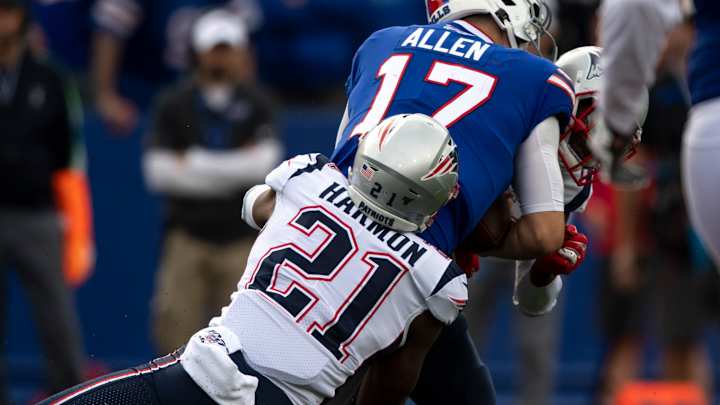Lions Didn't Get Much Better by Trading Quandre Diggs

The Lions traded safety Quandre Diggs and a 2021 seventh-round draft pick to the Seattle Seahawks in exchange for a 2020 fifth-round draft pick -- No. 172 overall -- before the trade deadline last season.
At the time, it was a highly criticized move.
For the most part, many still don't like the value the Lions got in return.
Trading away a captain and Pro Bowl alternate for a fifth-round pick? That seemed to be a one-sided trade until recently.
This week, the Lions traded for S Duron Harmon from the Patriots.
The Patriots received the Lions' fifth-round pick that they received in the Diggs trade, while the Lions got Harmon and a seventh-rounder (No. 235 overall).
To look at the two trades from a different viewpoint, the Lions basically traded Diggs and a 2021 seventh-round draft pick for Harmon and a 2020 seventh-round pick.
In the end, the Lions essentially netted Harmon for Diggs.
Now, whether you would rather have Diggs or Harmon is a whole other question.
Let's do a quick breakdown, and compare the two individuals.
First off, Diggs, 27, is a couple of years younger, and was drafted in 2015, whereas Harmon was drafted in 2013.
Although Harmon comes with a cheaper contract, he only has one year left on his deal as compared to Diggs who's under contract for two more seasons.
Despite Harmon only starting 17 games in comparison to Diggs' 37 over the past three seasons, their snap counts are actually pretty close on a per-year basis -- with Diggs averaging 80 more total defensive snaps per season.
In terms of play style, both players are considered free safeties.
Diggs was aligned as a free safety on 74 percent of his snaps in 2019, 50 percent of the time in 2018 and 76 percent of the time after his position switch in 2017.
Meanwhile, Harmon lined up deep on 73 percent of his snaps in 2019, 76 percent of his snaps in 2018 and 84 percent of the time in 2017.
While Harmon can play a lot of single-high safety in heavy man-coverage schemes, Diggs probably didn't have quite as much range as the Lions would have liked when all alone over the top.
In the Seahawks' predominant cover-3 scheme, Diggs is still the center fielder in their system.
But, he only has to account for the middle third of the field and not the whole field -- as in cover-1.
According to Pro Football Focus, Harmon has put together the sixth-highest free safety coverage grade (92.6) since 2015.
When targeted, the former Patriot has a forced incompletion rate of 36 percent -- No. 1 in the NFL over that span.
While both safeties can be considered "ball hawks," Harmon -- who was given the nickname of "The Closer" -- does have a slight advantage in terms of interceptions over the past three seasons.
Harmon has produced 10 picks in comparison to Diggs' nine since 2017.
As for touchdowns allowed during that time, Diggs has given up a total of six while in coverage, as compared to a total of three allowed by Harmon.
Now, one area of the game in which Diggs excels in is the physicality aspect.
Diggs is four inches shorter and seven pounds lighter than Harmon.
However, opposing offenses would never guess that after being tackled by Diggs.
He is a hammer coming downhill.
With the good comes the bad, though.
Diggs' aggression can get him in trouble at times -- the reason for his 33 missed tackles since he switched to safety.
With the Lions, he would often go for the high risk, yet highly-rewarding knock-out blow instead of wrapping up.
Meanwhile, not nearly as violent, Harmon takes a more calculated approach to tackling.
With a more controlled style, Harmon has committed just 13 missed tackles over the past three years.
Important to note, though, Diggs has accumulated almost double the number of tackles. Still, when going by the tackling efficiency rating, Harmon is the more reliable tackler.
Overall, there are pros and cons to both players.
Harmon gives the team a true single-high deep safety to allow fellow safeties Tracy Walker and Will Harris to play more underneath. Meanwhile, Diggs provides more of an enforcer-like mentality in the middle.
In theory, the Lions traded one style of safety for another, with Harmon providing an upgrade in the pass coverage and securing-of-tackles department.
And at the very least, Harmon is apparently a better fit for the "culture" the Lions are trying to build.
Related

Logan is a staff writer who has covered the Detroit Lions for many seasons. Known for his analytical perspectives and ability to scout college prospects, Logan brings a unique and fresh perspective to covering the NFL and the NFL Draft.